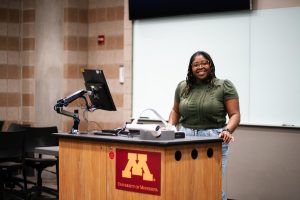As the devastation of the Interstate 35W bridge collapse – which came in both human and capital forms – mounts, many around the world are asking the obvious question: How could this happen?
A group of University researchers from the civil engineering department will evaluate the collapse in its own academic investigation, which unofficially began Tuesday morning with an informal visit to the site.
The team is currently working to submit a proposal to the National Science Foundation to secure funding.
Assistant professor of civil engineering Taichiro Okazaki will lead the University’s effort to piece together the evidence from the bridge and attempt to understand what happened.
Okazaki, who specializes in steel structures and earthquake engineering, said Minnesota Department of Transportation officials worked to grant University representatives access to the site. This allows researchers to begin taking photographs before debris is cleared to get the most accurate depiction of the area.
Government officials escorted the researchers to the area.
Due to the magnitude and tragic circumstances of the disaster, Okazaki said it is important that University investigators have face-to-face contact with government workers on the scene.
“We have the utmost respect for the agencies who are down there. They’re very hard at work,” he said. “We want to be very sensitive, and we’re taking it one step at a time. We don’t want to put additional burdens or stress on the agencies.”
Okazaki and his team will cooperate with government agencies by offering any assistance they can in the official investigation.
“Our long-term goal is to identify exactly what happened and that information can effectively prevent events like this in the future,” he said.
This isn’t the first time University representatives have collaborated to conduct research on the bridge.
In 2001, University civil engineering department researchers conducted an exhaustive study commissioned by MnDOT about the bridge’s viability.
The evaluation, which focused on the possibility of fatigue cracking on the highly trafficked transitway, found no imminent problems but recommended focused future inspection.
No fatigue cracking was apparent in the bridge’s deck truss, which is the main support for the structure’s roadway. But there were early signs of fatigue on secondary support trusses, which hold the main part of the bridge in place.
As a response, researchers recommended continued inspections of the most-stressed areas of the main and floor trusses.
“The research helped determine that the fatigue cracking of the deck truss is not likely, which means that the bridge should not have any problems with fatigue cracking in the foreseeable future,” the report read.
But still, a week after the accident, officials are looking for answers.
Gene Corley, a structural engineer from an Illinois-based consulting firm, who has led and participated in several follow-up investigations, including those of the Sept. 11 attacks and the 1989 Lake Street Bridge collapse, said the University report’s safety suggestions were reasonable.
“I don’t think that I would’ve seen any different recommendations in any other report,” he said. “Clearly what was done is not enough, not that (MnDOT officials) weren’t doing whatever they thought was the right thing to do.”
Fatigue cracking could be the explanation for the collapse, though there are several other possible causes, said Civil Engineering Department Head Roberto Ballarini.
Concrete slabs serving as roadway reinforcement atop the bridge, unseen cracks in steel supports and foundation settling could each have played into last week’s accident, he said.
At the time of the collapse, MnDOT officials said construction workers were doing routine, superficial concrete repairs.
MnDOT spokesman Kent Barnard likened the work to painting a house – completely external and without affecting the bridge’s support structure.
“This was a catastrophic failure; something really went wrong,” said Ballarini, who used the bridge daily in his commute to the University.
“Something certainly triggered this.”
Minnesota state bridge engineer Dan Dorgan said at a news conference Thursday the bridge had been inspected annually since 1993. Prior to that, inspections were conducted biennially.
Dorgan said safety concerns on the bridge included corrosion of the bearings, corrosion of the steel around the joints of the bridge, and cracking.
Complicating matters, the architectural style of the bridge provided little redundancy, meaning if one part faltered, the entire structure would fall, Ballarini said.
Original construction of the bridge concluded in 1967, and the “non-redundant” design – in which the bridge is supported on either side of the river without having a base directly above the river – was common at the time.
And though trends in structural designs of bridges have evolved to perhaps more efficient styles, Ballarini said the less-redundant design is not necessarily more dangerous.
“If you make anything, especially with these (types of bridges), you want to maintain them,” he said. “You need to keep them as close to pristine as possible.”
The bridge had been classified by Federal Highway Administration officials as “structurally deficient” since 1990, but Dorgan said the label is not as dire as it might sound.
“The designation does not prove repairs are necessary or that the bridge was dangerous or in need of immediate replacement,” he said.
Officials designate bridges as structurally deficient if assessments show lackluster structural ratings based on federal criteria.
At last inspection, the collapsed bridge’s superstructure received the lowest possible rating to go without modifications. The superstructure is every part of the bridge between the concrete support structure reaching to the ground and the road atop the bridge.
MnDOT will conduct its own investigation into what caused the collapse, but an independent consulting firm will perform a parallel investigation to ensure thoroughness.
Gov. Tim Pawlenty announced last week the structural engineering firm Wiss, Janney, Elstner Associates, Inc. will carry out the second inspection.
Corley, a private-sector investigator, said a second opinion never hurts.
“The one thing that the outside investigators can bring is a fresh approach,” he said. “Quite often, that is beyond what any individual in the state might have Ö It does take care of any worries that someone might have that they might not be getting the whole story (from government investigators).”













